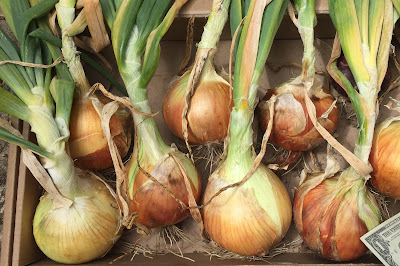 |
| Garlic. 6.4.18 |
 |
| Sweet Corn. 6.4.18 |
Most of the kitchen garden is doing well. The main problems have been herbivores. I've worked on several solutions, and some of those have helped.
The garlic was browsed even in low wire fencing tunnels. I thought that was deer, but maybe rabbits. After spraying with deer deterrent spray, the browsing stopped. That may have been the size of the plant, and not the spray. I've given a couple of doses of fish emulsion, and am still watering the garlic plants. In late winter, I had also spread some Milorganite. Might have been too much. The leaf tips have some browning, but otherwise the plants look robust. I think the crop will be good. The rotation for the garlic bed: 2 years ago, wild/weed/blackberry; last year, sweet corn, this year, garlic.
The first batches of sweetcorn look good. I forget the name, the first was an early yellow cold tolerant variety. The second bath was Trinity. The third batch was also Trinity, but I don't know if it's growing. I am using the low fencing tunnels on the sweet corn too, to inhibit browsing, and so far that seems to be working. The rotation: 2 years ago, squash, last year, potato, this year, sweet corn.
 |
| Tomatoes. 6.4.18 |
The tomatoes are looking good. these were grown from seeds too. The location was the duck pen from this winter. Some are blooming and have small green tomatoes. Many varieties. I planted them deeply for better dry tolerance. They had some Epsom Salts earlier to green up the leaves, and some fish emulsion, but now no more fertilizer. They are fenced in to prevent deer browsing. The rotation: Three years ago, Squash. Two years ago, sweet corn. Last year, garlic. This year, tomatoes.
 |
| Blue Potato Flower. 6.4.18 |
 |
| Potatoes. 6.4.18 |
The potatoes are looking better than almost anything else. They are lush and green. I used store bought starts, and also sprouted potatoes from the garage. There are Burbank Russet, Yukon Gold, Blue, and some I don't know from the sprouted ones. This year I planted in trenches, which I filled in as they grew, because I found that hilling them up seemed to require more watering. The trenches don't shed water. The first batch had some frost kill, but otherwise they all tolerated early planting and are growing very nicely. I did use some Milorganite when planting them, otherwise no fertilizer. The rotation: Two years ago, Indian Corn, last year, onions, this year, potatoes.
There are lots of other things. The rabbits and/or deer have browsed the onions so heavily, I don't think there will be much of a crop. The low fencing tunnels were not enough to prevent browsing, and the rabbit/deer deterrent spray was minimally helpful. I still have my doubts about the chili peppers, which so far look stunted. I've given them some Epsom salts and fish emulsion, we'll see. The gladiolas, zinnias, and marigolds are looking pretty good now too.



















































